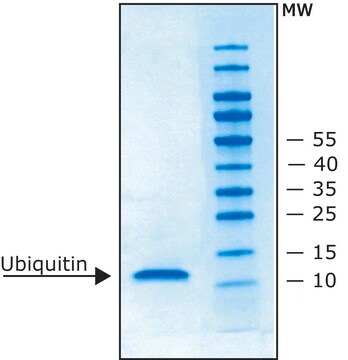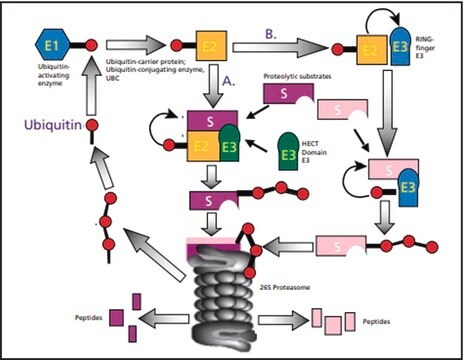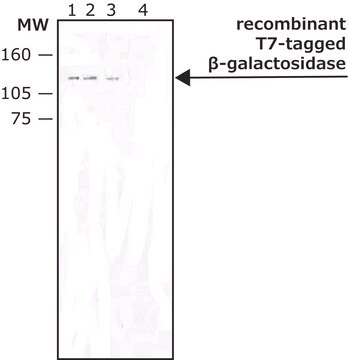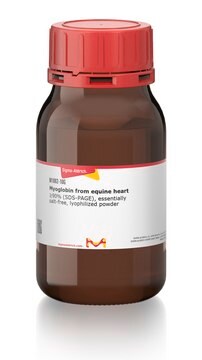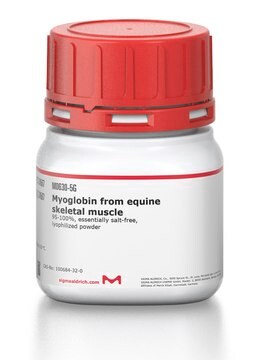U6253
Ubiquitin from bovine erythrocytes
BioUltra, ≥98% (SDS-PAGE), essentially salt-free, lyophilized powder
Synonym(s):
ATP-dependent proteolytic factor, Ub
Sign Into View Organizational & Contract Pricing
All Photos(2)
About This Item
Recommended Products
biological source
bovine erythrocytes
Quality Level
product line
BioUltra
Assay
≥98% (SDS-PAGE)
form
essentially salt-free, lyophilized powder
storage condition
(Tightly closed. Dry)
technique(s)
western blot: suitable
impurities
salt, essentially free
solubility
water: 1 mg/mL, clear, colorless
UniProt accession no.
storage temp.
2-8°C
Gene Information
bovine ... LOC(101902760)
Looking for similar products? Visit Product Comparison Guide
Related Categories
General description
Research area: Cancer
Ubiquitin is a highly conserved regulatory protein. It is found in all eukaryotic cells and is virtually identical across all forms of life including yeast, humans, and plants. ubiquitin structure contains seven Lys residues and an N-terminus, all of which are target sites for ubiquitination.
Ubiquitin is a highly conserved regulatory protein. It is found in all eukaryotic cells and is virtually identical across all forms of life including yeast, humans, and plants. ubiquitin structure contains seven Lys residues and an N-terminus, all of which are target sites for ubiquitination.
This product is from bovine red blood cells. It is not a recombinant product. The production process is considered proprietary, however it includes heat treatment as well as purification by chromatography and dialysis.
Application
Ubiquitin from bovine erythrocytes has been used to study the role of exogenous ubiquitin in chronic β-adrenergic receptor (β-AR)-stimulated myocardial remodeling. It has also been used to test the inhibitor of nuclear factor kappa-B kinase subunit beta (IKKβ) ubiquitylation.
Ubiquitin from bovine erythrocytes can be used for in vitro ubiquitinylation assay. The product can also be used as a marker in western blotting.
Ubiquitin from bovine erythrocytes can be used for in vitro ubiquitinylation assay. The product can also be used as a marker in western blotting.
Biochem/physiol Actions
Ubiquitination is a post-translational modification process where ubiquitin-protein is attached to a substrate protein. Ubiquitination plays a vital role in the regulation of cellular signaling in various biological processes such as apoptosis, protein processing, immune response, and DNA repair. Ubiquitination mediates protein degradation via the ubiquitin-proteasome pathway. Ubiquitination is implicated in various cellular signaling pathways. Polyubiquitination modulates the signal activation of NF-κ-B inhibitor alpha (IkB-α) in the inflammatory signaling pathway. Elevated levels of ubiquitin have been observed in various diseases such as parasitic and allergic diseases, alcoholic liver disease, type 2 diabetes, β2-microglobulin amyloidosis, and chronic hemodialysis.
Preparation Note
Ubiquitin from bovine erythrocytes can dissolved in water at 1 mg/ml to yield a clear, colorless solution.
antibody
Product No.
Description
Pricing
Storage Class Code
11 - Combustible Solids
WGK
WGK 3
Flash Point(F)
Not applicable
Flash Point(C)
Not applicable
Personal Protective Equipment
dust mask type N95 (US), Eyeshields, Gloves
Choose from one of the most recent versions:
Already Own This Product?
Find documentation for the products that you have recently purchased in the Document Library.
A L Schwartz et al.
Annual review of medicine, 50, 57-74 (1999-03-12)
The ubiquitin-proteasome pathway plays a pivotal role in the degradation of short-lived and regulatory proteins important in a variety of basic cellular processes, including regulation of the cell cycle, modulation of cell surface receptors and ion channels, and antigen presentation.
Frederik Lermyte et al.
The Analyst, 142(18), 3388-3399 (2017-08-16)
Electron transfer dissociation (ETD) is becoming increasingly important in mass spectrometry-based analysis of peptides and proteins. Supplemental collisional activation of undissociated electron transfer products can significantly increase fragmentation yield and sequence coverage, but hydrogen rearrangements - specifically, transfer of a
Frederik Lermyte et al.
Journal of the American Society for Mass Spectrometry, 28(1), 69-76 (2016-08-09)
Owing to its versatility, electron transfer dissociation (ETD) has become one of the most commonly utilized fragmentation techniques in both native and non-native top-down mass spectrometry. However, several competing reactions-primarily different forms of charge reduction-occur under ETD conditions, as evidenced
The ubiquitin system for protein degradation.
A Hershko et al.
Annual review of biochemistry, 61, 761-807 (1992-01-01)
Errol W Robinson et al.
Analytical chemistry, 80(19), 7508-7515 (2008-08-30)
Field asymmetric waveform ion mobility spectrometry (FAIMS) has emerged as an analytical tool of broad utility, especially in conjunction with mass spectrometry. Of particular promise is the use of FAIMS and 2-D ion mobility methods that combine FAIMS with conventional
Our team of scientists has experience in all areas of research including Life Science, Material Science, Chemical Synthesis, Chromatography, Analytical and many others.
Contact Technical Service